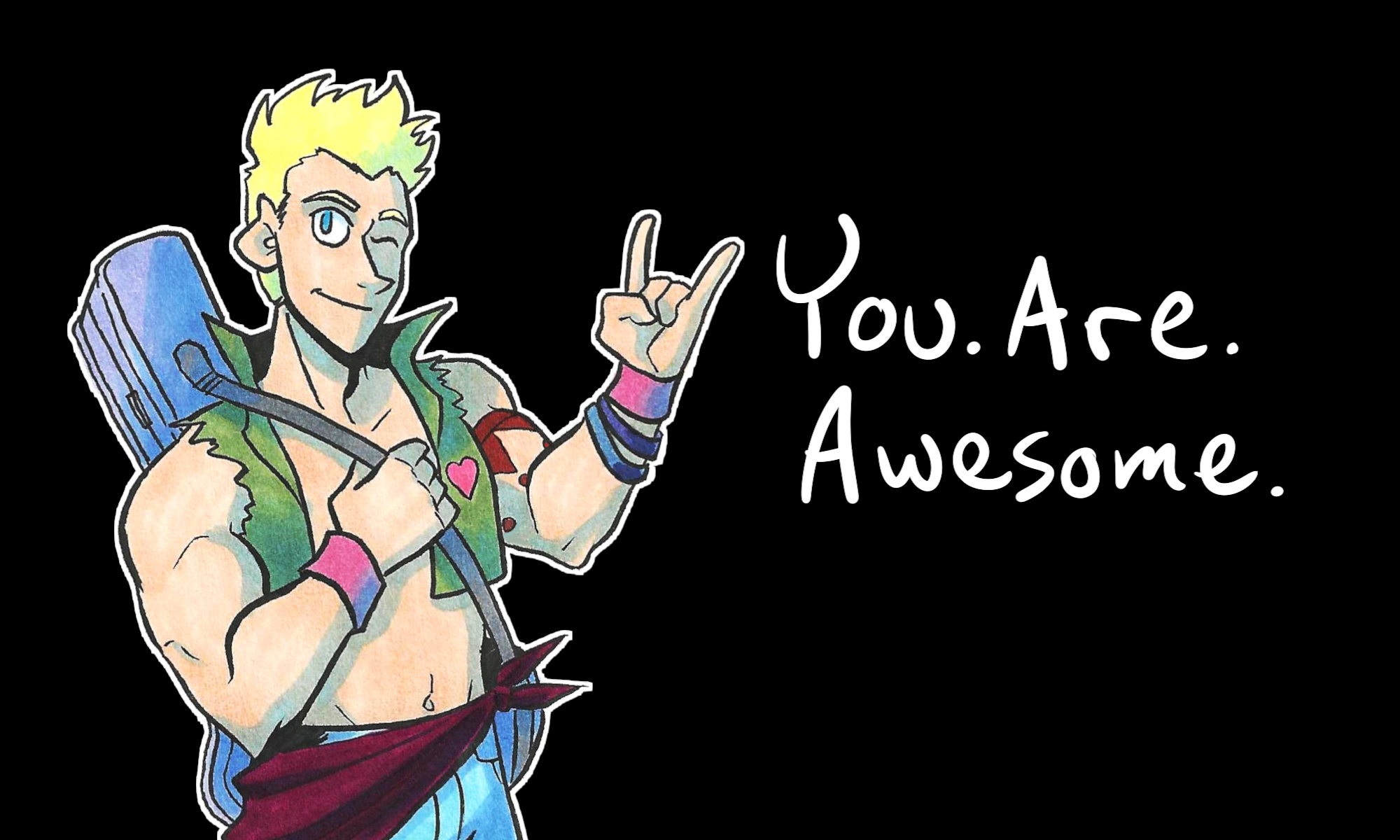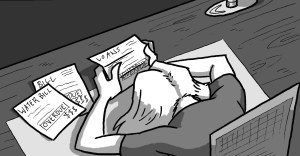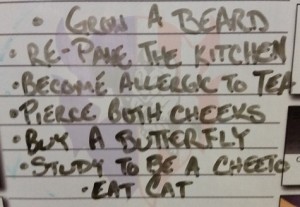A while back I made a video showing the first third of a sketchbook I finished this last December. To see that, watch Part 1, the video, below: Continue reading “December 2014’s Sketchbook… in Vlog”
How to Draw When You Feel Uninspired
So you have your sketchbook open, your pencils ready, your watercolors waiting and eager to do your bidding.
There’s just one problem.
You don’t know what to draw.
This scenario happens to all artists no matter their place in their career path or their preference of artistic tools.
Every artist gets to a point where they just. Don’t. Know. What to draw.
But here’s a secret:
There’s billions of things you can draw.
If you don’t believe me, here are some suggestions for you.
1. Draw what’s close to you right now.
Where are you? Your room? The barber shop? The grocery store? Find a thing to observe, get out your paper and pencil, and draw what you see.
2. Draw something you’re not used to drawing.
Are you primarily a cartoonist who draws people? Try drawing some trees in the park. Try drawing some animals, like song birds, squirrels, dogs, deer, skunks, cats, parrots, ladybugs. Draw people dancing, sleeping, wrestling, shopping when they don’t want to shop, being indignant, smiling at an old acquaintance. Draw that pine tree you see out your back door. Draw that trash can that tipped over in the wind.
3. Have a theme on stand-by.
Sometimes it helps your drawing ability if you have a theme at the ready. That way you don’t have to spend too much energy trying to think of what topic to draw from.
For example, for me, January was the month I would draw Superhero Ladies in my sketchbook. When I opened my sketchbook and would say to myself, “Jeez, what can I draw?” I remember the theme and go, “Oh yeah! I’m going to draw a Superhero Lady. Let’s get started…”
The themes are up to you, but here are some fun ones to draw on (…puns!):
- The Apocalypse
- Frogs
- Desert animals
- People with mustaches
- jewelry from around the world
4. Ask yourself what you want to accomplish when you sketch.
Are you sketching to improve your ability to draw the human nose? Or horses? Improving your use of colors? Want to build your memory bank so you don’t have to draw from reference? Do you want to draw better from reference?
Are you drawing just for fun? Or to get out an impulse? Did you have a bizarro dream?
You should have a reason to approach your sketchbook and draw. Otherwise…
5. Walk away and take a break.
This is perfectly ok. Sometimes you can make yourself draw, but if you have other things to do, do those things instead.
Sometimes the reason we’re stuck is because our mind is preoccupied with other things. Take care of those things so you can approach your sketchbook with a clear head.
There’s been times I could not draw because I was thinking, “I gotta’ do laundry. So I’ll throw in a load and then I’ll get back to this.”
99 percent of the time this works for me.
6. Is there something that ticks you off? Draw it.
Art is a good outlet for our emotions so that we don’t damage other people’s property. So next time you feel overwhelmingly angry, upset, frustrated, or depressed, get your sketchbook and just let it out.
7. Try a new tool.
Do you usually work in pencil? Try watercolors. Do you usually draw with pen and ink? Pick up some pastels.
Will you suck? Probably.
But experimenting with tools will help your mind break from its usual patterns and try something new and strange.

I have found that routine, while helpful sometimes, gets you into a pattern that eventually runs dry in inspiration. The above tips will, I hope, help you break out of the routine and experiment with something new.
Because art is an experiment. It’s a way to test tools, ideas, and yourself.
So go for it!
Thank you for reading, and I’ll see you on Monday.
The Absurd List Exercise
A few years ago, back when I lived closer to Columbus, my big sis wrote this, in permanent marker, on a dry erase board.
We have never been able to wash this off, so nearly ten years later, we still have this list tacked to the refrigerator, and it makes us laugh.
Seeing this inspires me to try a new idea as a warm-up writing exercise.
The exercise?
Make an absurd list.
It doesn’t have to have a theme like “What to Do When I Grow Up,” but if it helps you get your silly gears going, then go for it.
So I just did my free-writing list of “What to Do When I Grow Up,” and this is what I came up with:
- Learn to Cook a Unicorn
- Speak Cat
- Shave my eyebrows
- Lint-roll the dog
- Make a sweater for the Eiffel Tower
- High five Adolf Hitler in the face
- Fly with the owls
- Stretch my toes into Nickelodeon slime
- host a Dalek tea party
- Put sunglasses on Shakespeare’s dead body
- arm wrestle the sun
The fun thing about the Absurd List is that it gets your creative muscles moving, and that means you’ll be more receptive to ideas and suggestions, whcih is always a good thing in creative work.
Share some of your absurd lists in the comments below!
Thank you for reading, and I’ll see you tomorrow.
10,000 Mistakes and Why You Should Make Them

As I’m writing this blog post I can’t help but think of all the posts I have written that have been scrapped. I have written and scrapped well over 20 blog post since I started updating consistently. I also made a video blog today, and scrapped that.
And it makes me feel like a failure because I’ve made these things and none of them work.
But there are little ideas within those failures that I feel like I want to revisit and build upon.
Today I want to talk about failure.
Failure is something that not a lot of people like to talk about. Some people actively encourage failure but they don’t talk about how that feels, and I’m going to say yes, it does suck.
It makes you feel like everything that you make is terrible, and if this thing you made is terrible then maybe everything else that you have made is awful too. It’s a quick path to beating yourself up and thinking you’re not good enough.
But you gotta take that energy (or what little you have left of it) and keep moving forward.
I’m actually (this will sound banana pants crazy) grateful that I failed today. Because even though I did fail in writing blog posts, I got an idea out of it, out of the things that I failed to make, and hopefully that will lead to a successful blog post or video blog.
It reminds me of the adage that was coined in my time as a caricature artist at Cedar Point. It was based off of the 10,000 hour rule.
There is a rule coined in the book Outliers that said if you practice something for 10,000 hours then you’ll become a master of it.
The caricature department took this and said when you start drawing caricatures you will draw 10,000 terrible faces before you draw a good one.
So get those 10,000 faces out now as quickly and as creatively as you can. Learn from them. Keep making terrible faces. And after 10,000 times you’ll start to get good.
I’m still making comics. I’m still making blog post. I haven’t quite reached the 10,000 benchmark yet for either of them but I have noticed that the more often that I do something, the better I get at it.
So the more blog post that I write the better I get at writing them. The more comics that I make the better I get at making comics.
Not every comic or blog post has to work, but you have to get it out of your system. Because once you get the bad work out of the way you move on to the next thing. And maybe the next thing will be good.
This conundrum of failure, and making 10,000 of something before you can get good, reminds me of a scenario from the book Art and Fear by David Bayles and Ted Orland. The scenario took two sets of pottery students. The professor told the first set of students they had a whole semester to make one very good pot. Then they told the second set of students they had to make as many pots as possible. This was done to see who would make the better pots – the students who focus on one pot the whole semester or the students who made as many pots as they could.

They found that when students focused on making the perfect pot, the pots actually turned out worse. Because the students spent all of their time agonizing over how to make the pot perfect, artistically and aesthetically, and didn’t actually make it until the very end.
However, when students were encouraged to make as many pots as possible, they found that the more pots students made, the more great pots they had at the end. Not every pot was a masterpiece, but they had more great pieces than the students who made only one pot after agonizing over how to make it perfect.
And if you take anything away from this, I hope it’s that: that torturing yourself over making something perfect is not worth it.
Because there’s another masterpiece waiting for you, within you, already.
So make as much work as you can. Make as many mistakes as you can. And keep creating.
Because with every mistake you make, you’ll also make something brilliant.
Thank you for reading, and I’ll see you tomorrow.
How to Take a Day Off
I realized something recently.
I was finishing some comics on Sunday morning, and then I went to a shift at my day job as a Michael’s cashier.
And when I got home, I splurged for myself and knitted and crocheted ALL OF THE THINGS.

The reason?
I needed a little time off to do something for myself.
And then I realized that, as a freelancer, I don’t do that nearly as often as I think I do.
As freelancers, we all need a little time off.
Freelancing is a lot of running around to manage everything, from finances to invoicing to actually making the things you promised to make for that client who forgot to pay you last week and –
It’s chaotic.
Sometimes the chaos is fun, in a “How will I kick Chaos’ ass THIS time” kind of way.
However, it can be really easy to get caught up in the chaos and never take a day off.
On the other hand, it’s easy to take a lot of days off.
Freelancing gives us the ability to set our own schedules, which is both awesome and terrifying.
It’s awesome because if you need to take a day to help mom move a fridge, get a haircut at some random hour of the day, or drive into the city to get a thing, you can totally do that.
But it’s terrifying because it’s easy to fall into one of two extremes: too many days off, or not enough of them.
Too many days off means you’ll be cramming to meet your deadlines, and that can infringe on your ability to meet promises you made to the folks outside of your work. Did you promise your sister you would drive her over to a friend’s house? Well you can’t do it because you have a deadline to meet and you slacked off too much earlier this week.
Too few days off means you’ll start seeing numbers in your sleep, you’ll see everything you do as “work” or “in the way of work,” and your friends and family will be deeply concerned for your health and possibly have the hospital on speed-dial.
So how do you handle this conundrum?
It’s all about balance.
It’s all about knowing when you’ve worked too many days, when you’ve taken off too much time, and knowing how your body and mind acts in those scenarios.
Listen to your body.
Don’t overwork yourself to the point that you get sick. Don’t take off so much time that you start sleeping in for eleven hours and wake up even more tired than you anticipated.
Know the rhythms of your body. Know when it’s tired, when it’s active and driven to get work done.
Make a schedule and stick to it.
If you are the type to make schedules and stick to them (like I am), decide how many days off you need and incorporate it into your flow. I usually do two days off, but they don’t have to be consecutive. Even if it’s mega-crunch time, I make room for one day off, at least.
If you are the type to not make schedules, then figure out the number of days off you would need in a given week/month/quarter and incorporate it into your flow. Do you need two days off in a row? Ok. Or do you need three days off a week? This will depend on your lifestyle and your responsibilities, but always make sure you have time off and that it’s balanced with your work.
And relax.
It will get done.
I know sometimes I tend to overwork myself because I feel a sense of urgency. Like, “If I don’t get this done now, it will never get done!”
That’s bull-crap.
Things will get done. Your project will get finished, and then you will move on to the next one.
Nothing needs to be done “right now.” It just needs done.
How soon, or how late, is up to you.
I’m not telling you to shurk your deadlines.
I’m telling you that if you need to take a breather so you’re not overworked, take that breather.
Take care of yourself first. The rest will follow.
I hope this helped you in some way. Please take good care of yourselves.
So when was your last day off? Did you do anything/nothing/all of the things? Leave a comment!
Thanks for reading, and I’ll see you on Friday.


